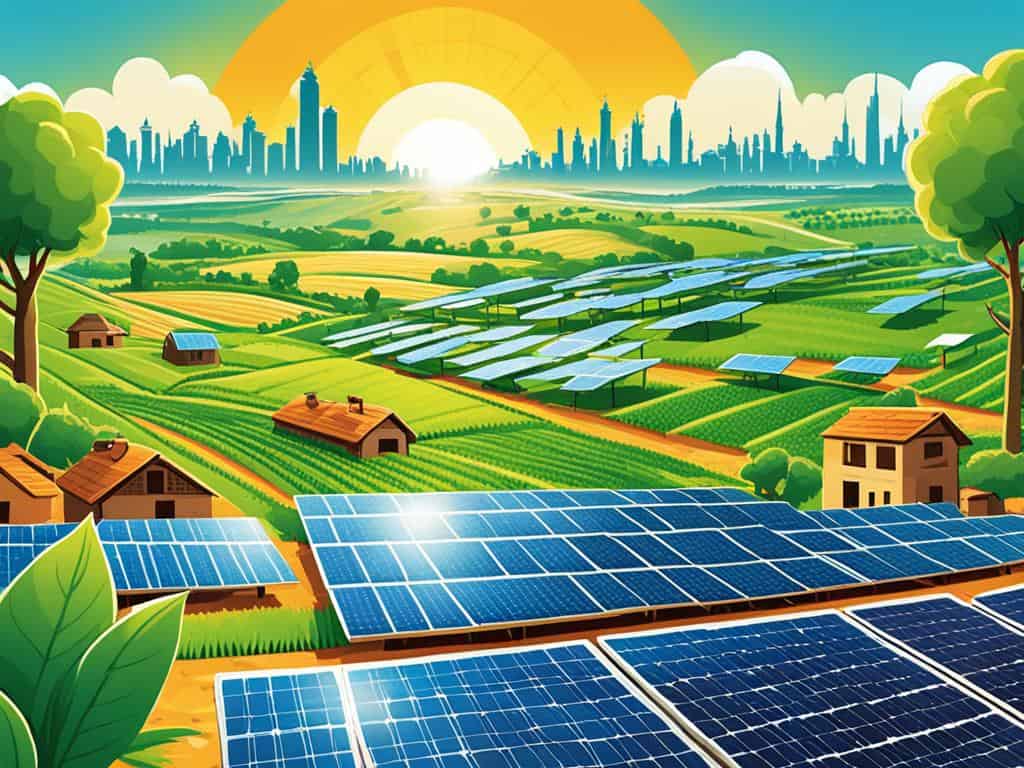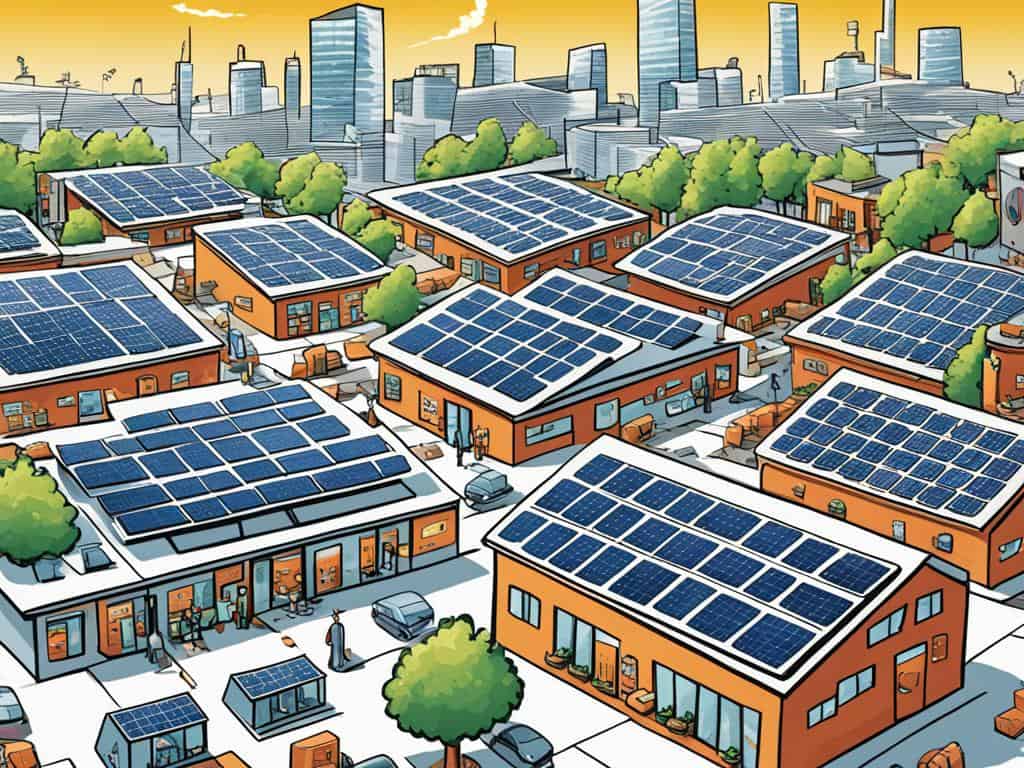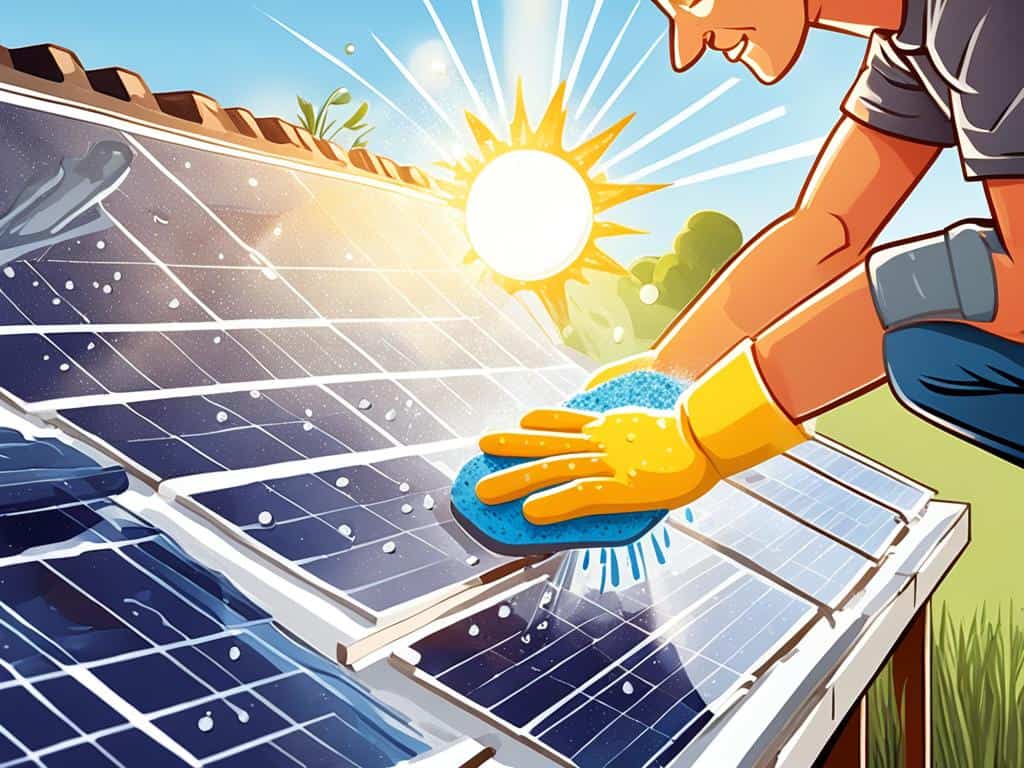Revolutionizing Energy: The Function and Impact of Solar Plates
Explore the transformative power of solar plates in India’s energy landscape. Discover how this sustainable technology is shaping a greener future.

As the sun shines on the Indian landscape, a silent revolution unfolds. Solar plates are changing India’s energy story. By the end of 2021, India reached a milestone with a solar capacity of 50.5 GW. This marks a big step in the world of sustainable power. Solar technology is fast advancing, bringing new opportunities within India’s energy landscape. Innovations range from half-cell technology to solar panels that integrate into buildings beautifully.
Fenice Energy is leading the shift towards solar innovation. We tap into the sun’s power, aiming for a green future. Thanks to advancements in technology, facilitated by companies like us, India is on a new path. This change in energy transformation is not just for today but for the future. Explore the role of solar plates in pushing forward a sustainable revolution.
Key Takeaways
- India’s impressive growth in solar plate installations, achieving a 50.5 GW capacity.
- Innovative applications of solar technology, like floating solar panels in Tamil Nadu.
- Advancements in solar panel efficiency through half-cell technology and microinverters.
- The significant role of solar storage, with lithium-ion batteries at the helm.
- Ideas in sustainability reaching new heights with IoT and cloud-based solar monitoring systems.
- The crucial influence of solar plates on reducing carbon footprints and promoting clean energy.
- Fenice Energy’s commitment to spearheading the solar plate revolution in India.
Understanding Solar Energy and the Role of Solar Plates
The world of renewable energy is changing fast, thanks to photovoltaic technology. We explore how solar plates are key in this change. They help turn sunlight into power and are different from old energy sources.
Basics of Photovoltaic Technology and Solar Plates
Photovoltaic technology captures the sun’s vast power. It turns it into solar energy. The magic happens in solar plates. Silicon cells in these plates catch photons and start electron flow, making direct current (DC). This amazing process is at the core of solar systems on houses and large solar farms.
The Direct Conversion Process from Sunlight to Electricity
The conversion from sunlight to electricity by photovoltaic cells is super efficient. It shows how far solar plate printing technology has come. It involves detailed silicon wafer patterning and careful material layering. This lets us use solar power on a small scale and big projects effectively.
Comparing Solar Energy with Conventional Energy Sources
Solar power is more sustainable than fossil fuels. It changes how we think about making and using energy. Fenice Energy is leading the change towards renewable options. It shows solar plates are practical and good for the environment in India’s big energy landscape.
| Factor | Solar Energy (Photovoltaic) | Conventional Energy (Fossil Fuels) |
|---|---|---|
| Source | Sunlight (Renewable) | Coal/Oil/Gas (Non-renewable) |
| Efficiency | 18% (Monocrystalline) | Varies, generally lower due efficiency losses in heat production |
| Environmental Impact | Reduces pollution, no emissions during operation | High emissions, significant pollution |
| Maintenance Costs | Low; no moving parts | Higher; often involves expensive extractions and transport |
| Longevity | Up to 30 years with proper care | Varies, but plants and machinery often require regular replacement |
| Scale of Use | Residential to Utility | Mainly commercial and Industrial |
| Output | DC Electricity, converted to AC for use | AC Electricity, ready for immediate use |
| Integration with Grid | Seamless, with potential to supply excess back to grid | Depends on central generation capacity |
This table highlights solar energy as a top renewable energy choice. Fenice Energy is leading the way in India. The many benefits show why solar plates are the future of energy production.
The Eco-Friendly Advantages of Solar Plate Use
Solar plate technology does more than clean energy production. It’s a big step in ecological care and innovation. It brings art and culture into the renewable energy discussion.
At Fenice Energy, we see the vast good in using solar energy. It helps cut down pollutants and protect our ecosystems. As more people choose cleaner power, they help preserve India’s natural beauty.
Environmental Benefits: A Path towards Cleaner Energy
Solar power helps make energy cleaner. It stops the release of dangerous chemicals into the air. In places like India, where clean air is needed, choosing solar can make a big difference.
Reduction in Airborne Pollutants and Carbon Footprint
Solar power needs little water and doesn’t pollute. As energy costs go up, it’s a smart choice. It reduces the need for finite energy sources, cutting down our carbon footprint.
Contribution to Biodiversity Preservation and Ecosystem Balance
Solar panels are great for keeping our planet diverse and balanced. Things like community solar programs offer clean power without harming nature. They help India’s biodiversity flourish.
Fenice Energy works towards making India’s energy clean and sustainable. We handle everything from start to finish. Our goal is to make clean energy a benefit for now and the future. To see how solar can change your energy use, check the website of Fenice Energy
| Eco-Friendly Attribute | Benefit | Impact on India |
|---|---|---|
| Reduction in Airborne Pollutants | Decreased air pollution | Improved public health and air quality |
| Minimal Water Requirements | Conservation of water resources | Less strain on local water supply, helping in droughts |
| Biodiversity Preservation | Stronger ecosystems | Keeps India’s plants and animals safe |
| Energy Independence | Less need for imported fuels | Better national security and stable economy |
| Community Solar Programs | Clean energy for everyone | Makes energy fair and easy to get |
Solar Plate Economics: Cost Savings and Incentives
As solar energy incentives grow, so does the use of advanced solar plate technique. Homeowners and businesses in India are finding big cost savings. Fenice Energy leads this shift, offering eco-friendly energy solutions that make the most of solar plate economics.
Solar investments save money on energy and boost property value. Research from Lawrence Berkeley National Laboratory shows solar panels can add about Rs 1,125,000 to a house’s value. With solar’s rise in the US and India, its positive effect on the economy is big and increasing.
Federal help has made solar economics even better. In the U.S., people get a 30% tax break till 2019, then it drops slightly by 2021. In India, solar power costs dropped dramatically, which led to solar being 9% of the nation’s energy mix.
India aims to boost its solar capacity significantly by 2022. This growth benefits from solar panels and will position India as a top solar market. It’s also creating jobs for over 242,000 people in the solar sector.
Both national and state governments in India offer sweet deals for going solar. These benefits, like tax credits and cash back, help citizens lower costs and support a greener India.
Fenice Energy combines new solar tech with strong incentives, ensuring India progresses in solar adoption wisely. This approach leads to lower electricity bills now and offers lasting advantages like job creation and energy self-reliance. It shows investing in solar in India is smart and beneficial for the future.
Solar Plate Innovations: From Theory to Practical Systems
The solar plate industry is quickly growing. New technologies are making solar energy more efficient and practical. Less than 5% of global solar energy is used, offering huge growth potential. India is leading the way to a future powered by the sun. Innovations like half-cell technology and floating PV panels are changing the solar energy field.
Advancements in Half-Cell Technology for Enhanced Efficiency
Half-cell technology is setting new standards for solar efficiency. By cutting solar cells into half, it lowers internal resistance and boosts efficiency. This is key for reaching India’s renewable energy targets. Solar plate innovations like these are breaking through efficiency barriers. For example, LONGi reached a 33.5% efficiency in the lab. Though these high-efficiency cells are small, there’s work to make them bigger for wider use.
Building-Integrated Photovoltaics (BIPV) and Aesthetic Solar Solutions
Building-integrated photovoltaics mix design and function beautifully. BIPV makes solar technology part of the building material. This approach supports aesthetic solar solutions that blend with architecture. BIPV makes buildings smarter and greener. Its wider use depends on high efficiency, like Oxford PV’s 28.6% efficient solar cell.
Floating PV Panels: Maximizing Space and Efficiency
Floating PV panels let us use water for solar power, saving land. These floating PV panels benefit from water’s cooling, boosting efficiency. As energy needs grow, these panels offer a clever way to meet demand without harming the earth.
Solar panel innovation also focuses on longevity. Today’s solar cells keep most of their capacity for 25 years. This durability shows how sustainable and reliable solar technology is. It’s crucial for our future energy needs.
| Statistical Indicator | Data Point | Relevance to Innovations |
|---|---|---|
| Global Solar Energy Utilization | Under 5% | Room for expansion by implementing solar plate innovations like half-cell technology |
| World Energy Consumption Projection by 2040 | 56% Growth | Indicates potential demand for efficient solar systems like BIPV and floating panels |
| CO₂ Offset by 4 KW Solar Panel | 199,697 lbs over 25 years | Emphasizes the green benefits of adopting solar plate technology in homes |
| Solar Cell Efficiency Milestone | Over 30% | Highlights achievement in panel efficiency via half-cell and multi-junction technologies |
Fenice Energy and others are tackling the challenge of solar efficiency above 35%. The journey of solar innovation is making India’s solar scene brighter and more efficient.
Revolutionizing Residential Energy with Solar Plates
Using residential solar energy is now a current reality. It’s not just a dream for the future. This change comes with innovations like the solar plate press. This lets homeowners in India use the sun to power their homes. Doing this helps create a greener and cleaner energy world. Fenice Energy helps make this possible, letting people make their electricity.
Workshops on solarplate technology play a big role in this change. They explain how solar energy works in simple terms. They show not only how it helps the planet but also saves money. Solar plates are now a smart choice. They help lower energy bills and are better for the environment.
Since 1954, solar cell efficiency has jumped from 6% to over 20%. This is a huge improvement. Now, we have cells that work even better, some over 40%. Plus, there are panels that catch sunlight from both sides. These advances show how solar energy keeps getting better. This is especially good in places like India where the sun is strong.
- Bifacial panels and PERC technology change the game in crowded cities where space is limited.
- Keeping panels clean and effective is easier now. A tool called the Frank Solar Mop is helping in over 150 projects in India.
- Solar tracking systems also help by adjusting to get the most sunlight. This is great for places with changing weather.
Thinking about getting solar panels? Consider their efficiency, warranty, cost, and how to install them. Also, think about how it helps the planet and saves money over time. Fenice Energy has answers to these questions.
Innovations keep making solar power better. For example, LONGi hitting a 26.81% efficiency rate. Or tandem cells that now exceed 33% efficiency. With every advance, solar energy becomes an essential part of our homes.
A green and sustainable future is possible with solar technology. Every home can help achieve energy independence. All it takes is the smart use of solar plates.
Commercial and Industrial Adoption of Solar Plates
In India, businesses are moving towards cleaner energy, like solar power. This change helps the environment and pushes our economy to use resources smarter. Fenice Energy is leading this shift with its renewable energy options. They help companies make this eco-friendly switch.
Large-Scale Solar Farms and the Impact on Industrial Power Generation
Large solar farms are changing how we generate power. Companies like Trina Solar and Reliance Industries are making big moves in solar energy. They’re part of why the Asia Pacific region, including India, might see a 7% growth in solar energy from 2024 to 2032.
The solar rooftop market might reach INR 31.7 billion by 2032. There’s a demand for more types of energy. Fenice Energy is at the forefront, offering installation services that improve how industries work.
Corporate Investments in Solar Energy as Part of Sustainability Goals
Companies are investing in solar energy both to protect the environment and save money. These efforts line up with global goals for a greener world. India’s tax laws offer benefits for these investments, making it easier for companies to see a quick financial return from going solar.
The Ministry of New and Renewable Energy in India has a goal. They want to achieve 10,000 megawatts from renewables by 2030. This reflects India’s strong plan to support a switch to renewable energy.
Trends in Solar Energy Purchase Agreements by Business Entities
More businesses are signing solar energy purchase agreements. These deals guarantee them a stable power supply. They also show that solar energy is a reliable source. On top of that, the Income-tax Act gives a 40% rebate for solar projects, making this option even more attractive.
Companies are quickly moving towards solar power, driven by smart economics and care for the environment. The goal is to make operations better with solar technology. This technology gives them strength, efficiency, and higher profits without price limits.

Solar Plate Technology: Microinverters and System Scalability
The rise of solar plate technology and microinverters is transforming India’s power scene. India ranked third globally in the 2021 Renewable Energy Country Attractiveness Index. By late December 2021, India’s total solar capacity hit 50.5 GW. A highlight is the 48-acre floating solar plant in Tuticorin, Tamil Nadu. It uses floating PV modules, showing innovative ways to generate solar power.
Microinverters have become popular because they are 96.5% efficient. This is better than traditional inverters. They convert solar power to usable power at home, boosting performance and safety. They also let us add more solar panels easily without redoing the whole setup.
System scalability means efficient and adaptable solar systems. Today’s solar setups include smart monitoring. Homeowners can check their system’s performance and energy use on their phones or laptops. This means better control over energy use.
Microinverters are perfect for solar plate artists and solar etching fans who value precision. They also have longer warranties, usually 20-25 years. This offers more peace of mind compared to the 10-15 year warranties of conventional inverters.
The shift towards lithium-ion solar batteries marks progress in sustainable energy. These batteries last longer and are safer. Hybrid inverters, offering power levels like 3.6kW, 5kW, and 8kW, match home energy needs well.
But, as seen with Growatt’s basic string inverters, not all inverters are the same. The MIC 750TL-X to MIC 3300TL-X range shows different power needs. For example, some inverters need at least 125V to start. It’s important to match the solar setup with the inverter for best performance.
Fenice Energy’s approach combines solar plate technology and microinverters. Their products and customer service push India towards a cleaner future. For more on their clean energy solutions, visit https://feniceenergy.com.
In summary, India is leading in renewable energy with advanced microinverters and scalable systems. The mix of high-tech engineering and art, like solar etching, creates unique and green energy solutions. It epitomizes the essence of the modern solar plate artist.
Storage Solutions: The Integration of Solar Batteries
The push for green energy makes solar batteries essential for reliable solar energy storage. Fenice Energy is committed to ensuring energy is available even when the sun isn’t shining. They support battery systems that help maintain a strong solar grid in India.
Extending Solar Utilization Beyond Daylight Hours with Batteries
Solar energy storage is advancing thanks to solar batteries. They save the energy collected during the day for use at night or when it’s cloudy. This approach allows us to use solar power all day and night, changing the way we use solar energy.
Transitioning to Lithium-Ion Batteries: Advantages in Lifespan and Weight
Switching to lithium-ion batteries offers major benefits for solar use. These batteries are better because they last longer, are lighter, and take up less space. Since Sony started using them in 1991, they’ve become a top choice for renewable energy efforts.
Monitoring and Management Systems for Optimized Energy Storage
Solar monitoring systems are key to improving solar storage. They help manage energy better by tracking and optimizing how we use power. Fenice Energy champions these smart systems to boost India’s solar capabilities to world-class levels.
Let’s compare battery technologies to help you choose the best for your solar system:
| Battery Type | Capacity | Lifespan | Cost (INR) | Advantages |
|---|---|---|---|---|
| Lithium-Ion | 120 MWh | 7-15 years | 52,58,000 – 1,05,16,000 | Higher energy density, lighter weight, more efficient |
| Lead-Acid | Varies | 1-10 years | 15,000 – 60,000 | Cost-effective for home solar setups |
| Nickel-Cadmium | Varies | Varies | Varies | Suited for industrial applications |
| Flow Batteries | Varies | Varies | Varies | Long duration, quick response |
In conclusion, the growth of solar batteries, especially lithium-ion batteries, is changing solar energy storage systems. With solar monitoring systems, we’re entering a new phase. This could greatly save money and help the environment.
The Next Frontier: Space Solar Power Initiative (SSPI)
The search for ongoing, green energy has led us to the stars, thanks to Space Solar Power Initiative (SSPI). This groundbreaking project aims to gather and send solar energy directly from space to Earth. It opens the door to endless, eco-friendly energy.

SSPI matches India’s green goals perfectly, aiming to use clean, endless space solar power. Fenice Energy backs this project, seeing the big changes it could bring. By widening our clean energy options, SSPI can boost progress while protecting Earth.
Fenice Energy is serious about finding new ways to use clean energy, like advanced solar setups. Working with projects like SSPI shows its commitment to a planet-friendly future.
| SSPI Component | Description | Advantages |
|---|---|---|
| Ultralight Photovoltaics | These are light, space-friendly solar panels. | They work better and cut space travel costs. |
| Phased-array Systems | This tech sends solar energy to Earth wirelessly. | It transmits energy well with little waste. |
| Wireless Power Transmission | This is how energy travels without needing cables. | It could mean energy is always available worldwide. |
SSPI is more than an energy source; it’s a sign of a bright, green future. It shows what we can do with creativity. As SSPI develops, Fenice Energy aims to bring this innovation into its services.
Supporting SSPI shows a strong push for reliable, green energy solutions. It highlights India’s commitment to leading the global community towards a better, sustainable path.
The Visionary Push: Pioneering Figures and Collaborative Efforts
The solar energy field is growing fast, thanks to visionary solar leaders. These leaders work with schools in academic-industry partnerships which speed up solar plate development. Together, they are making big steps in clean energy. India is becoming a major force in this area.
Leaders in Solar Plate Research and Development
In India, passionate leaders are driving solar tech forward. They design ways to use the sun’s power more efficiently. This makes solar energy easier to get for more people.
Collaboration between Academic Institutions and Industry Giants
Colleges in India are hotspots for solar research. They work with big companies to find new solar tech solutions. This teamwork brings new ideas to life and helps use them in the real world.
Cross-Disciplinary Contributions to Solar Plate Innovation
Different experts are joining hands to improve solar plate technology. Engineers, environmentalists, and business people work together. Their goal is to make green solutions that are also affordable.
| Statistic | Observation |
|---|---|
| Women Workforce Participation | 32% on average in renewable energy, with 45% in administrative, 28% in technical, 35% in non-technical roles |
| Funding Challenges and Initiatives | Most common challenge for female entrepreneurs; addressed by initiatives like We-fi and WIT |
| Women’s Support Networks | WIRE and WRISE are key in helping women in the energy field |
| Global Solar Workforce Participation | There are big chances in the solar sector, especially in places like India and Africa |
These facts show how important women are in renewable energy. Support from groups and specific targets help increase their presence. The growth of solar power in countries like India brings more jobs and makes energy greener. Fenice Energy is focused on bringing diversity and new ideas into energy, using solar technology for a cleaner future.
Conclusion
India is seeing a big change thanks to solar energy. Solar panels are leading the way for a cleaner, sustainable future. Their use has risen, showing the importance of renewable energy in powering our lives. Most solar panels use crystalline silicon cells. This technology has a massive 95% market share as of 2021.
Solar plates have come a long way from a small invention to a big solution. There’s been a huge increase in solar installations, which has made costs go down. Solar systems have also gotten smarter and safer. Fenice Energy is part of this revolution. They provide solar solutions that meet India’s energy needs. With more solar power, we’re taking a big step towards using renewable energy.
More people are using solar technology, from big projects to home panels. This shows how good solar plates are. Innovations are making solar panels more efficient and less expensive. The cost of big solar projects is now competing with traditional energy. Fenice Energy is leading the push for sustainable, affordable energy in India. By using the sun’s power better, we’re moving towards a sustainable future with solar plates.


